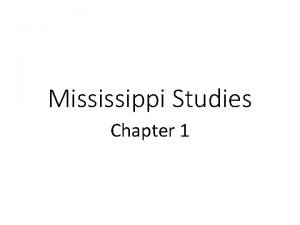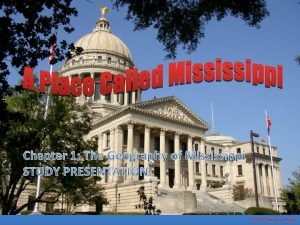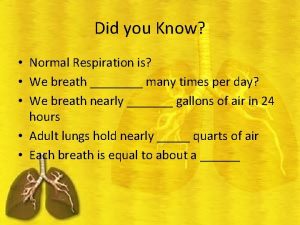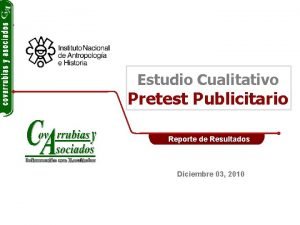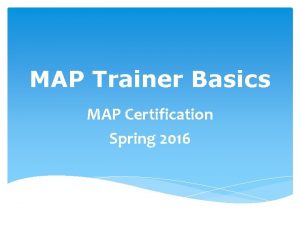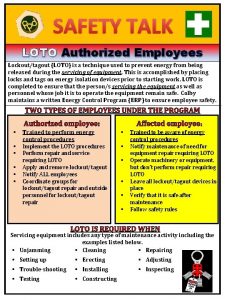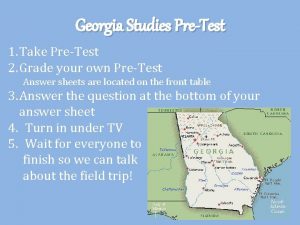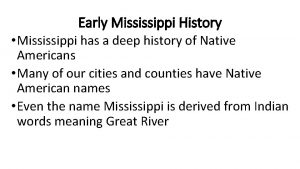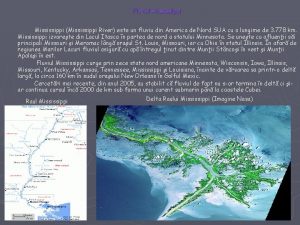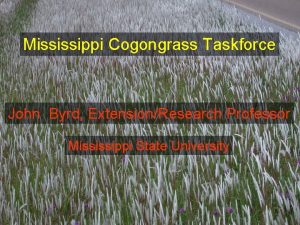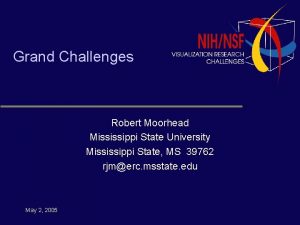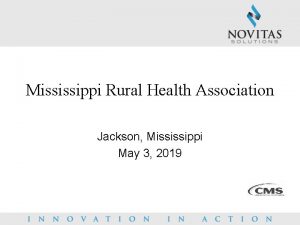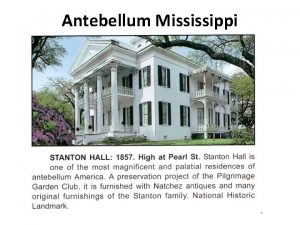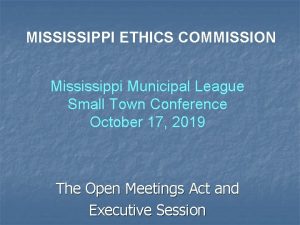MISSISSIPPI STUDIES Chapter 1 PreTest Get out a






















































- Slides: 54

MISSISSIPPI STUDIES Chapter 1

Pre-Test • Get out a clean sheet of paper • Number the paper 1 through 5 and answer the following questions 1. What were two of the main Indian Tribes in Mississippi? 2. Who were the first Europeans in Mississippi? • A. Spanish B. French C. British 3. What is the average summer temperature in Mississippi? • A. 70 B. 80 C. 90 4. Which of the following is considered the coldest month in Mississippi? • A. November B. December C. January 5. Who discovered the Mississippi River? • A. Hernando De. Soto B. Robert de La. Salle C. D’Iberville

Early Mississippi History • Mississippi has a deep history or Native Americans • Many of our cities and counties have Native American names • Even the name Mississippi is derived from Indian words meaning Great River

Prehistoric Cultures • Paleo Culture 10, 000 B. C. – 8, 000 B. C. • Archaic Culture 8, 000 B. C. – 500 B. C. • Woodland Culture 500 B. C. – 1, 000 A. D. • Mississippian Culture 1, 000 A. D. – 1, 600 A. D.

Early Mississippi History • Paleo Indians were the first people in Mississippi • It is believed they crossed the land bridge connecting Alaska and Russia • Mounds are the most visible legacy of the Native Americans • Uses: religious temples, homes, and burials • Emerald Mound in Mississippi is the 2 nd largest in the US • Most Native Americans live in clans • Clan – is a group of people who are related to each other

Early Native Americans • Paleo – Ice Age – Earliest Americans crossed land bridge from Siberia into Alaska (and downward from there) • Archaic – Climate warmer and drier – Native Americans adjusted to climate and became less nomadic • Woodland – Highly organized societies in Mississippi and Ohio River valleys developed – Built burial mounds over tombs – Moundbuilders – lived alongside rivers and streams (see slides below) – Villages grew larger and tied together politically – Used bow and arrow

Mississippian • built religious buildings and the homes of chiefs on top of their flat, rectangular mounds • Choctaw connect their early history with a mound called Nanih Waiya [Na’-na Wai’-a] along the Pearl River in southeastern Winston County

In Natchez

The Temple Mound at Winterville

Mound sites in Mississippi • Bear Creek • Pharr • Owl Creek • Bynum • Winterville • Jaketown • Nanih Waiya • Pocahontas • Boyd • Emerald • Grand Village

Mississippi Tribes (tribes in red indicate the larger tribes) • • • • CHICKASAW (north Mississippi) TAPOSA CHAKCHIUMA IBITOUPA TIOU YAZOO HOUMA KOROA TUNICA NATCHEZ (south Mississippi) CHOCTAW (central Mississippi) ACOLAPISSA BILOXI PASCAGOULA


CHOCTAW • Connect early history with Nanih Waiya (Winston County) • Had 25 to 30 villages and each person had a voice in government • Major crop: maize (corn) • One of three largest tribes • The only major visible tribe in Mississippi today • (Choctaw Code Talkers – Choctaw nation – not just Mississippi) http: //www. youtube. com/watch? v=3 Y 0 mm. Vxxr 3 w

NATCHEZ • “Great Sun” chief lived on top of mound here • Major crop: maize (corn) • One of three largest tribes • http: //www. wlbt. com/story/15279745/emerald-mound-in-natchez

CHICKASAW • Major crop: maize (corn) • One of three largest tribes

MISSISSIPPIAN NATIVE AMERICANS Smaller tribes: Choula, Pascagoula, Tunica, Biloxi Larger tribes: Chickasaw, Choctaw, Natchez Major crop: maize (corn) Well organized and had developed ways of life that fit into environment (HUMAN-ENVIRONMENT INTERACTION) • Each village included several clans (groups of related families) • Punished criminals • Protected individuals from violence • Exogamy: practice of marrying outside the clan • Polygyny: having more than one wife (occasionally, a man in tribe had two wives) • Built villages close to streams/creeks • Religious beliefs: centered on sun and the sacred fires (represented sun on Earth); believed in many spirits associated with nature and animals • •

SPANISH EXPLORERS • First to visit MS • (1539 -1542) Hernando de Soto explored area searching for gold and silver • Attacked north of Mobile by Native Americans but NA did not know how to fight soldiers so were defeated • Introduced horses/hogs to America • MAIN OUTCOME: diseases spread from Spanish to Native Americans who had no immunity to them • Repeatedly attacked by Native Americans • Reached Gulf of Mexico and sailed to Mexico • Never returned

FRENCH EXPLORERS • Visited MS after Spaniards • Originally settled in Quebec, Canada and explored from there • 1673: Louis Jolliet (trader) and Father Jacques Marquette (missionary) sailed down MS River and reached present-day site Rosedale, MS • Turned around when they realized that river flowed into Gulf and not Pacific Ocean • 1682: Rene Cavelier, de La Salle, Henri de Tonti, and Father Membre traveled down MS River and claimed region for France • From 1699 to 1763, the future state of Mississippi was a part of the French colony of Louisiana. • During these years, the French explored the region, established settlements and military outposts, engaged in political and economic relations with the area’s American Indians, and sought to establish a profitable economy • Fort Maurepas – first permanent settlement in MS

French: built Fort Rosalie in 1716 (Natchez)

BRITISH MISSISSIPPI • MS officially part of province West Florida (1763) (included southern halves of Alabama and MS as well as parts of Florida) • 1783 Treaty of Paris (between US and Great Britain…peace treaty of Revolutionary War): US controlled southern boundary at 31 degrees north latitude • Spain held territory south of that line (refused to give up Natchez District which was north of line) • Spain signed the Treaty of San Lorenzo (Pinckney’s Treaty) in 1795 in which it recognized the 31 st parallel as the boundary between Spanish Florida and the United States.

SETTLEMENTS • Spain, England, and France established colonial settlements in eastern North America • First European settlement in MS – Ocean Springs • Mississippi ruled first by French, then English, and finally Spain • Mississippi Territory - after centuries of control by several European powers, the land that would become Mississippi became a part of the United States at the close of the 18 th century… April 7, 1798, Congress created the Mississippi Territory


Mississippi Territory • Most Europeans living in the territory lived along the MS River • Natchez was the capital of the territory • By 1817 the Mississippi Territory applied for statehood • However the US Congress did not want to allow it to be a state because it was too large • As a result the split the territory • December 10, 1817 MS became the 20 th state of the US


MISSISSIPPI’S CLIMATE

Mississippi’s Climate • Climate – conditions of the atmosphere over a long period of time • Weather – conditions of the atmosphere over a short period of time • Humid subtropical climate (long hot summers; short mild winters) • Average yearly temperature is 62 degrees • Average summer temperature is 80 degrees • Average winter temperature is 48 degrees • January is the coldest month • Receives about 55 inches of rainfall a year • Because of MS’s climate agriculture is important to its economy • Growing season





Storms • Tornadoes • Funnel shaped clouds that cause massive destruction • Smith County in MS and the state of MS are the most likely places in the nation to receive a tornado • MS has more deaths from tornadoes than any other state • Tornadoes are measured on the Fujita Scale • The weather channel now also uses Tor: con


TOR: CON Value Descriptions 8+ Very high probability of a tornado 6 - High probability of a tornado 4 - Moderate chance of a tornado nearby, but hail and/or high wind gusts possible 2 - Low chance of a tornado, but hail and/or high wind gusts possible 0 - Near-zero chance of a tornado or a severe thunderstorm






Storms • Hurricanes • Storms that form in the Atlantic Ocean with winds of at least 74 mph – 155 mph + • They are measured on the Saffir-Simpson scale using numbers 1 -5 • Usually called category • There have been two major hurricanes in Mississippi • Camille 1969 • Katrina 2005






REGIONS Of Mississippi

Six Major Regions

1. Delta • A flat, alluvial plain that runs along the banks of the MS River from Memphis to Vicksburg • The soil allows for the growth of large cotton crops • Farming in the 1800 s was based on Sharecropping

2. Loess Hills • Their economy is based on cattle, light manufacturing, and industry

3. Red Clay Hills • This area is ideal for crops especially cotton because there are few trees • Economy: trade, commerce, and industry

4. Northeast Highlands • Woodall Mountain is the highest point in the state


5. Piney Woods • This area was the center of the lumber and railroad industry at one time • As a result boom towns were created to provide for lumber and railroad companies • Hattiesburg and Laurel are two boom towns that are still successful today

6. Gulf Coast • MS has five barrier islands off the coast • 1. Horn Island • The largest • Used for biological weapons testing • 2. Cat Island • It got its name from the French who thought raccoons were cats • Used in WWII to train dogs for military service • Hurricane Katrina washed part of the island away • 3. Deer Island • Closest to the coast • It got its name because deer escaped to the island • 4. Ship Island • Hurricane Camille split the Island into two pieces • It is the only deep water harbor between the MS River and Mobile Bay

6. Gulf Coast Continued • 5. Petit Bois • French for Little Woods • The Mississippi Sound is the area of water between the barrier islands and the coast • The Gulf Coast was the first area to be explored and settled • Their main economic activities are fishing and tourism
 Metaphors in one direction songs
Metaphors in one direction songs Get on get off
Get on get off Reading review chapter 7 ms studies
Reading review chapter 7 ms studies Mississippi studies chapter 1
Mississippi studies chapter 1 Ms studies chapter 1
Ms studies chapter 1 Paradigm shift from women studies to gender studies
Paradigm shift from women studies to gender studies Get up get moving quiz
Get up get moving quiz Get up get moving quiz
Get up get moving quiz Get up get moving
Get up get moving Pseudocode sequence
Pseudocode sequence Get focused get results
Get focused get results Germer
Germer Brown loam region
Brown loam region How to get a radical out of the denominator
How to get a radical out of the denominator Get out of jail free card
Get out of jail free card Get out of my school
Get out of my school What options did an accused witch have in salem
What options did an accused witch have in salem Get the word out we back up
Get the word out we back up Do words have power
Do words have power The second foundation get out of debt
The second foundation get out of debt 10 up
10 up A piece get out of paper
A piece get out of paper Air knocked out of you
Air knocked out of you Pretest: developing an academic and career plan
Pretest: developing an academic and career plan The early and mid-nineteenth century: romanticism
The early and mid-nineteenth century: romanticism Blood administration pretest
Blood administration pretest Intravenous medication administration pretest
Intravenous medication administration pretest Pretest growth development and sexuality
Pretest growth development and sexuality Pretest publicitario
Pretest publicitario Pretest communism and the cold war
Pretest communism and the cold war Proxy pretest design
Proxy pretest design Pepp pretest
Pepp pretest Experimental design xo1
Experimental design xo1 Pretest loop c++
Pretest loop c++ Pretest art in the 20th century and today
Pretest art in the 20th century and today Pretest: the universe
Pretest: the universe Topic sentence test
Topic sentence test Parts of speech pretest
Parts of speech pretest Alejandro rodriguez vilela
Alejandro rodriguez vilela Wound care pretest
Wound care pretest Slopes
Slopes Hdmaster map
Hdmaster map Put out the light and put out the light
Put out the light and put out the light Meaning of out out by robert frost
Meaning of out out by robert frost Out of sight out of mind quotes
Out of sight out of mind quotes Robert frost out out
Robert frost out out Loto safety talk
Loto safety talk Robert frost out out
Robert frost out out Time
Time Matthew 11:30 msg
Matthew 11:30 msg Loto
Loto Out, damned spot! out, i say!
Out, damned spot! out, i say! Harmony not discord
Harmony not discord Makna out of sight out of mind
Makna out of sight out of mind Log out tag out deutsch
Log out tag out deutsch



